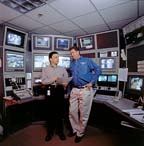Enterprise Access

Talk about a challenge. Almost everyone knows AT&T. It’s among the premier voice and data communications companies in the world. It runs one of the most sophisticated communications networks. As a leading supplier of data, Internet and managed services for the public and private sectors, AT&T offers outsourcing and consulting to large businesses and government, too.
With approximately $37 billion in revenue, AT&T has about 40 million residential customers and 4 million business customers.
Because of such an exciting mission, AT&T has an equally giant challenge to manage its real estate while it protects its employees, contractors and visitors as well as diverse and far-flung facilities and essential operations.
Enterprise Challenge
Talk about an access control challenge with emphasis on the enterprise.That's the mission of Vinnie Placco, AT&T security director; Brian McLeod, AT&T real estate security manager; and their team, which focus on enterprise access, all day, every day.
From AT&T’s Bedminster, N.J., facility, McLeod provides a range of support for facilities in the United States and internationally.
“The responsibility of the entire team centers on real estate technical services, and what we support is the security end,” says McLeod. This includes the corporate access control system, badging program and satellite facility identification operations. “We do the badging for all the AT&T groups and we also do access control for AT&T buildings,” he adds. Obviously, the mission is large, with an access control network that covers many buildings at 30 or so sites around the world.
Placco says that, as part of the technical support they provide to the enterprise, McLeod and his team program access controls for the various locations as well as provide access cards for most buildings. “But we don’t monitor everything from one central location. Instead, there are security control centers around the country.”
The security team sees the real estate security operation as one of standards, procedures and technical support for all AT&T properties in regard to environment, health, safety and security needs. “We basically put the framework together,” Placco observes.
Helping with that framework, since 1986, is Deterrent Technologies of Ocean, N.J. The firm, founded in 1982 as a one-stop systems provider for integrated electronic security systems, is ranked 31st nationwide in the SDM magazine’s Top Systems Integrators Report.
“We have worked closely over the years with AT&T as we helped move their system from Schlage to Westinghouse to NexWatch, where we have brought the system from analog to a complete enterprise solution with digital integration,” says John Maguire of Deterrent Technologies. “AT&T has been slightly ahead of the curve in both technology and the application of that technology.”
Deterrent also has been ahead of the curve.
Deterrent business and staff resources have grown. Founded in 1982 as a one-stop systems provider for integrated electronic security systems, its business and staff resources have grown dramatically in size and capability over the years. It has been involved in diverse projects ranging from the typical to prison locking systems, automatic security revolving doors, duress alarms that activate on sound or vibration and custom electronic consoles, just to name a few.
The system integrator has installations in over 40 states. It has manufacturing partners as well as a dealer network to accommodate national and international clients.
Deterrent is in the process of stepping AT&T up to the NexWatch, Oak Creek, Wis., ProWatch Corporate Edition, which will allow the real estate security operation’s card access system to tie into the corporation’s PeopleSoft human resources application. Integration of the databases is a solid step to even greater security, and it eliminates some procedures. “The security system takes the information from human resources that is needed for the security application,” adds Maguire. “For an appropriate reason, privileges can be terminated from either access control or human resources.”
The upgrade also means the card access system can go on the AT&T network, allowing security a yet closer relationship to information technology, better communications among many remote facilities as well as cutting the cost of separate wiring and systems.
The security team at Bedminster provides deep support. “We do all the programming for card access and at the additional locations, too,” says Jodi Smith, another member of the AT&T security team.
AT&T employees carry one photo identification card that permits them access into buildings and selected rooms in those buildings, depending on what is authorized, according to AT&T’s Dan Smith, a member of the security support team. “Our policy is to wear the badge so that it is visible. And we encourage our employees to challenge others [on site] who are not wearing a badge,” says Dan Smith.
The badge does display the AT&T logo, according to Placco. A typical badge has a white background, a photo of the person and AT&T logo or initials of the company, according to Placco. For added security, “there’s a hologram on the card, too,” says Smith. For contractors, the card indicates the person’s contractor status as well as listing the AT&T location for which that person has valid entry.
“There is an issue of cost, of course, for access cards. But the integrity of the card is very important,” says Greg Doele, a member of the AT&T security team. Card and card printer supplies is one of those costs and the AT&T team has centralized supplies for corporate ID badging.
While the AT&T-Deterrent relationship has, over the years, evaluated and instituted new technology advances, not everything has passed muster yet. A number of years ago, "we seriously considered smart cards, but at that time, they had not taken off," Mcguire says. "We moved into the digital world about five years ago.”
Evaluation of technology, upgrading of the access system and – more importantly – working to meet evolving needs of the client are three essential roles of the systems integrator.
AT&T currently utilizes the services of a number of security vendors for protection of its facilities domestically and internationally. On AT&T's long-term relationship with Deterrent, says Vinnie Placco, "We have found Deterrent to be open and sharing of ideas.”
The company, with the support of Deterrent, continues to work on integrating the access system with other security systems. There has been integration of digital hard drive recording and other elements of security, says Mcguire, including biometrics such as palm readers for greater security at certain locations.
Placco and McLeod both share the pride of helping direct a world-class security operation at one of the most recognized world-class companies – AT&T. But they both share the challenges that comes with that visible leadership.
“We have an obligation (outside of AT&T). Colleagues look to us and how we are addressing security procedures and policies, especially since September 11th,” observes Placco. Adds McLeod, “We must keep ahead of the game.”
Looking for a reprint of this article?
From high-res PDFs to custom plaques, order your copy today!




